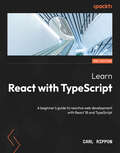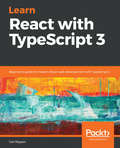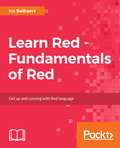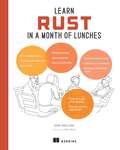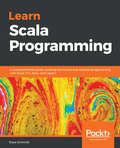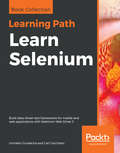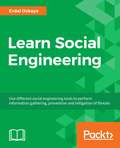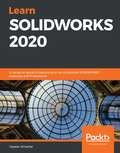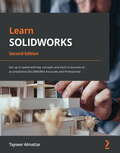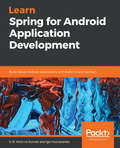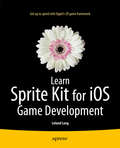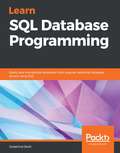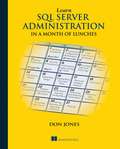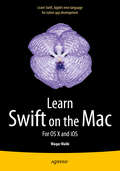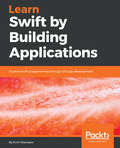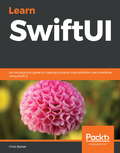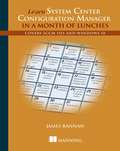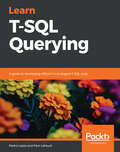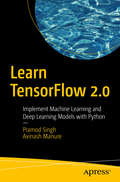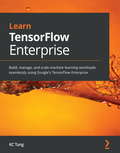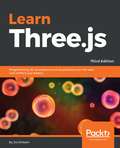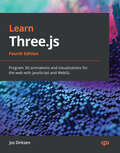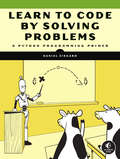- Table View
- List View
Learn React with TypeScript: A beginner's guide to reactive web development with React 18 and TypeScript, 2nd Edition
by Carl RipponTake your first step in building modern-day component-based web apps using the latest features and capabilities of React and TypeScript with this easy-to-follow guideKey FeaturesLearn to use different React hooks with TypeScriptExplore different styling approaches while building React web appsGain experience in using React Dev Tools to debug componentsPurchase of the print or Kindle book includes a free PDF eBookBook DescriptionReading, navigating, and debugging a large frontend codebase is a major issue faced by frontend developers. This book is designed to help web developers like you learn about ReactJS and TypeScript, both of which power large-scale apps for many organizations.This second edition of Learn React with TypeScript is updated, enhanced, and improved to cover new features of React 18 including hooks, state management libraries, and features of TypeScript 4. The book will enable you to create well-structured and reusable React components that are easy to read and maintain, leveraging modern design patterns.You'll be able to ensure that all your components are type-safe, making the most of TypeScript features, including some advanced types. You'll also learn how to manage complex states using Redux and how to interact with a GraphQL web API. Finally, you'll discover how to write robust unit tests for React components using Jest.By the end of the book, you'll be well-equipped to use both React and TypeScript.What you will learnGain first-hand experience of TypeScript and its productivity featuresUnderstand how to transpile your TypeScript code into JavaScript for running in a browserBuild a React frontend codebase with hooksInteract with REST and GraphQL web APIsDesign and develop strongly typed reusable componentsCreate automated component testsWho this book is forThis book is for experienced frontend developers looking to build large scale web applications using React and TypeScript. Intermediate knowledge of JavaScript, HTML and CSS is a prerequisite.
Learn React with TypeScript 3: Beginner's guide to modern React web development with TypeScript 3
by Carl RipponStart developing modern day component based web apps using React 16, Redux and TypeScript 3 with this easy to follow guide filled with practical examples.Key FeaturesLearn the latest and core features of React such as components, React Router, and suspenseDive into TypeScript 3 and it`s core components such as interfaces, types aliases, tuples, generics and much more.Build small-to-large scale single page applications with React, Redux, GraphQL and TypeScriptBook DescriptionReact today is one of the most preferred choices for frontend development. Using React with TypeScript enhances development experience and offers a powerful combination to develop high performing web apps. In this book, you’ll learn how to create well structured and reusable react components that are easy to read and maintain by leveraging modern web development techniques. We will start with learning core TypeScript programming concepts before moving on to building reusable React components. You'll learn how to ensure all your components are type-safe by leveraging TypeScript's capabilities, including the latest on Project references, Tuples in rest parameters, and much more. You'll then be introduced to core features of React such as React Router, managing state with Redux and applying logic in lifecycle methods. Further on, you'll discover the latest features of React such as hooks and suspense which will enable you to create powerful function-based components. You'll get to grips with GraphQL web API using Apollo client to make your app more interactive. Finally, you'll learn how to write robust unit tests for React components using Jest. By the end of the book, you'll be well versed with all you need to develop fully featured web apps with React and TypeScript.What you will learnGain a first-hand experience of TypeScript and its productivity features Transpile your TypeScript code into JavaScript for it to run in a browser Learn relevant advanced types in TypeScript for creating strongly typed and reusable components.Create stateful function-based components that handle lifecycle events using hooks Get to know what GraphQL is and how to work with it by executing basic queries to get familiar with the syntaxBecome confident in getting good unit testing coverage on your components using JestWho this book is forThe ideal target audience for this book are web developers who want to get started with creating modern day web apps with React and TypeScript.You are expected to have a basic understanding of JavaScript and HTML programming. No prior knowledge of TypeScript and React is needed.
Learn Red – Fundamentals of Red: Get up and running with the Red language for full-stack development
by Ivo BalbaertDiscover how to use the next-generation language Red for full-stack development, from systems coding over user-interfaces to blockchain programmingKey FeaturesExplore the latest features of Red to build scalable, fast, and secure applicationsLearn graphical programming and build highly sophisticated reactive applicationsGet familiar with the specific concepts and techniques of Red development, like working with series, viewing code as data, and using dialects.Book DescriptionA key problem of software development today is software bloat, where huge toolchains and development environments are needed in software coding and deployment. Red significantly reduces this bloat by offering a minimalist but complete toolchain. This is the first introductory book about it, and it will get you up and running with Red as quickly as possible.This book shows you how to write effective functions, reduce code redundancies, and improve code reuse. It will be helpful for new programmers who are starting out with Red to explore its wide and ever-growing package ecosystem and also for experienced developers who want to add Red to their skill set.The book presents the fundamentals of programming in Red and in-depth informative examples using a step-by-step approach. You will be taken through concepts and examples such as doing simple metaprogramming, functions, collections, GUI applications, and more. By the end of the book, you will be fully equipped to start your own projects in Red.What you will learn Set up your Red environment to achieve the highest productivity Get grounded in Red, gaining experience and insight through many examples and exercises Build simple, compact, and portable applications Analyze streams of data through Parse Compose GUI applications with View and Draw Get prepared for smart contract blockchain programming in RedWho this book is forThis book is for software developers and architects who want to learn Red because of its conciseness, flexibility, and expressiveness, and more specifically for its possibilities in GUI apps and blockchain / smart contracts programming. Some knowledge of the basic concepts and experience of any programming language is assumed.
Learn Robotics - Fundamentals of Robotics Programming: Build and control autonomous robots using Raspberry Pi 3 and Python
by Danny StapleA programmer, a developer or an enthusiast interested in robotics and developing a fully-functional robot would find this book helpful. No major experience required just some programming knowledge would be sufficient.
Learn Robotics Programming: Build and control AI-enabled autonomous robots using the Raspberry Pi and Python, 2nd Edition
by Danny StapleDevelop an extendable smart robot capable of performing a complex series of actions with Python and Raspberry PiKey FeaturesGet up to speed with the fundamentals of robotic programming and build intelligent robotsLearn how to program a voice agent to control and interact with your robot's behaviorEnable your robot to see its environment and avoid barriers using sensorsBook DescriptionWe live in an age where the most complex or repetitive tasks are automated. Smart robots have the potential to revolutionize how we perform all kinds of tasks with high accuracy and efficiency. With this second edition of Learn Robotics Programming, you'll see how a combination of the Raspberry Pi and Python can be a great starting point for robot programming. The book starts by introducing you to the basic structure of a robot and shows you how to design, build, and program it. As you make your way through the book, you'll add different outputs and sensors, learn robot building skills, and write code to add autonomous behavior using sensors and a camera. You'll also be able to upgrade your robot with Wi-Fi connectivity to control it using a smartphone. Finally, you'll understand how you can apply the skills that you've learned to visualize, lay out, build, and code your future robot building projects. By the end of this book, you'll have built an interesting robot that can perform basic artificial intelligence operations and be well versed in programming robots and creating complex robotics projects using what you've learned.What you will learnLeverage the features of the Raspberry Pi OSDiscover how to configure a Raspberry Pi to build an AI-enabled robotInterface motors and sensors with a Raspberry PiCode your robot to develop engaging and intelligent robot behaviorExplore AI behavior such as speech recognition and visual processingFind out how you can control AI robots with a mobile phone over Wi-FiUnderstand how to choose the right parts and assemble your robotWho this book is forThis second edition of Learn Robotics Programming is for programmers, developers, and robotics enthusiasts who want to develop a fully functional robot and leverage AI to build interactive robots. Basic knowledge of the Python programming language will help you understand the concepts covered in this robot programming book more effectively.
Learn Rust in a Month of Lunches (In a Month of Lunches)
by David MacLeodOne month. One hour a day. That&’s all it takes to start writing Rust code!Learn Rust in a Month of Lunches teaches you to write super fast and super safe Rust code through lessons you can fit in your lunch break. Crystal-clear explanations and focused, relevant examples make it accessible to anyone—even if you&’re learning Rust as your first programming language. By the time you&’re done reading Learn Rust in a Month of Lunches you&’ll be able to: Build real software in Rust Understand messages from the compiler and Clippy, Rust&’s coding coach Make informed decisions on the right types to use in any context Make sense of the Rust standard library and its commonly used items Use external Rust &“crates&” (libraries) for common tasks Comment and build documentation for your Rust code Work with crates that use async Rust Write simple declarative macros Explore test driven development in Rust Learn Rust in a Month of Lunches is full of 24 easy-to-digest lessons that ease you into real Rust programming. You&’ll learn essential Rust skills you can use for everything from system programming, to web applications, and games. By the time you&’re done learning, you&’ll know exactly what makes Rust unique—and be one of the thousands of developers who say it&’s their best loved language! About the technology Learn how to create fast powerful programs in Rust in just 24 short lessons! Rust gives you modern features like a top-notch compiler, a rich ecosystem of pre-built libraries, and the same low-level performance you get with a language like C, but without the awkward syntax, complex memory management, and code safety concerns. This book guides you step by step from your first line of code. About the book Learn Rust in a Month of Lunches breaks down the Rust language into concise hands-on lessons designed to be completed in an hour or less. The examples are fun and easy to follow, so you&’ll quickly progress from zero Rust knowledge to handling async and writing your own macros. You won&’t even need to install Rust—the book&’s code samples run in the browser-based Rust Playground. There&’s no easier way to get started! What's inside Build working Rust software Understand messages from the compiler and Clippy Use external Rust &“crates&” (libraries) for common tasks Explore test driven development in Rust About the reader No previous experience with Rust required. About the author Dave MacLeod was an educator, Korean-English translator, project controller, and copywriter before becoming a full-time Rust developer. The technical editor on this book was Jerry Kuch. Table of Contents 1 Some basics 2 Memory, variables, and ownership 3 More complex types 4 Building your own types 5 Generics, option, and result 6 More collections, more error handling 7 Traits: Making different types do the same thing 8 Iterators and closures 9 Iterators and closures again! 10 Lifetimes and interior mutability 11 Multiple threads and a lot more 12 More on closures, generics, and threads 13 Box and Rust documentation 14 Testing and building your code from tests 15 Default, the builder pattern, and Deref 16 Const, &“unsafe&” Rust, and external crates 17 Rust&’s most popular crates 18 Rust on your computer 19 More crates and async Rust 20 A tour of the standard library 21 Continuing the tour 22 Writing your own macros 23 Unfinished projects: Projects for you to finish 24 Unfinished projects, continued
Learn Scala Programming: A comprehensive guide covering functional and reactive programming with Scala 2.13, Akka, and Lagom
by Slava SchmidtA step-by-step guide in building high-performance scalable applications with the latest features of Scala.Key FeaturesDevelop a strong foundation in functional programming and Scala's Standard Library (STL)Get a detailed coverage of Lightbend Lagom—the latest microservices framework from LightbendUnderstand the Akka framework and learn event-based Programming with Scala Book DescriptionToday’s Scala is quite different from its earlier versions. The second version of the language is more than twelve years old and has undergone multiple changes related to supported features and library implementation. Scala 2.13, with its main focus on modularizing standard library and simplifying collections, brings around such a change one more time. This book addresses both technical and architectural changes by providing a comprehensive guide to the redesigned standard library and collections as well as covering in-depth type system and first-level support for functions. It will teach you how to leverage implicits as a primary mechanism for building type classes and looks at different ways to test Scala code. You will learn about abstract building blocks used in functional programming, giving understanding sufficient to pick up and use any existing functional programming library out there. The book will explore reactive programming by covering the Akka framework and reactive streams. Finally, 2 definitive projects will help you will build microservices and teach you how to implement them with Scala and Lagom framework.What you will learnAcquaint yourself with the new standard library of Scala 2.13Get to grips with the Grok functional paradigmsGet familiar with type system to express domain constraintsUnderstand the actor model and different Akka librariesGrasp the concept of building microservices using Lagom frameworkDeep dive into property-based testing and its practical applicationsWho this book is forThis book is for beginner to intermediate level Scala developers who would like to advance and gain knowledge of the intricacies of the Scala language, expand their functional programming tools, and explore actor-based concurrency models.
Learn Selenium: Build data-driven test frameworks for mobile and web applications with Selenium Web Driver 3
by Unmesh Gundecha Carl CocchiaroLearn end-to-end automation testing techniques for web and mobile browsers using Selenium WebDriver, AppiumDriver, Java, and TestNG Key Features Explore the Selenium grid architecture and build your own grid for browser and mobile devices Use ExtentReports for processing results and SauceLabs for cloud-based test services Unlock the full potential of Selenium to test your web applications. Book Description Selenium WebDriver 3.x is an open source API for testing both browser and mobile applications. With the help of this book, you can build a solid foundation and can easily perform end-to-end testing on web and mobile browsers.You'll begin by being introduced to the Selenium Page Object Model for software development. You'll architect your own framework with a scalable driver class, Java utility classes, and support for third-party tools and plugins. You'll design and build a Selenium grid from scratch to enable the framework to scale and support different browsers, mobile devices, and platforms.You'll strategize and handle a rich web UI using the advanced WebDriver API and learn techniques to handle real-time challenges in WebDriver. You'll perform different types of testing, such as cross-browser testing, load testing, and mobile testing. Finally, you will also be introduced to data-driven testing, using TestNG to create your own automation framework.By the end of this Learning Path, you'll be able to design your own automation testing framework and perform data-driven testing with Selenium WebDriver. This Learning Path includes content from the following Packt products: Selenium WebDriver 3 Practical Guide - Second Edition by Unmesh Gundecha Selenium Framework Design in Data-Driven Testing by Carl Cocchiaro What you will learn Use different mobile and desktop browser platforms with Selenium 3 Use the Actions API for performing various keyboard and mouse actions Design the Selenium Driver Class for local, remote, and third-party grid support Build page object classes with the Selenium Page Object Model Develop data-driven test classes using the TestNG framework Encapsulate data using the JSON protocol Build a Selenium Grid for RemoteWebDriver testing Build and use utility classes in synchronization, file I/O, reporting and test listener classes Who this book is for This Learning Path is ideal for software quality assurance/testing professionals, software project managers, or software developers interested in using Selenium for testing their applications. Professionals responsible for designing and building enterprise-based testing frameworks will also find this Learning Path useful. Prior programming experience in Java are TestNG is necessary.
Learn Social Engineering: Learn the art of human hacking with an internationally renowned expert
by Erdal OzkayaImprove information security by learning Social Engineering.Key FeaturesLearn to implement information security using social engineeringGet hands-on experience of using different tools such as Kali Linux, the Social Engineering toolkit and so onPractical approach towards learning social engineering, for IT securityBook DescriptionThis book will provide you with a holistic understanding of social engineering. It will help you to avoid and combat social engineering attacks by giving you a detailed insight into how a social engineer operates.Learn Social Engineering starts by giving you a grounding in the different types of social engineering attacks,and the damages they cause. It then sets up the lab environment to use different toolS and then perform social engineering steps such as information gathering. The book covers topics from baiting, phishing, and spear phishing, to pretexting and scareware.By the end of the book, you will be in a position to protect yourself andyour systems from social engineering threats and attacks.All in all, the book covers social engineering from A to Z , along with excerpts from many world wide known security experts.What you will learnLearn to implement information security using social engineeringLearn social engineering for IT securityUnderstand the role of social media in social engineeringGet acquainted with Practical Human hacking skillsLearn to think like a social engineerLearn to beat a social engineerWho this book is forThis book targets security professionals, security analysts, penetration testers, or any stakeholder working with information security who wants to learn how to use social engineering techniques. Prior knowledge of Kali Linux is an added advantage
Learn SOLIDWORKS 2020: A hands-on guide to becoming an accomplished SOLIDWORKS Associate and Professional
by Tayseer AlmattarExplore a practical and example-driven approach to understanding SOLIDWORKS 2020 and achieving CSWA and CSWP certification Key Features Gain comprehensive insights into the core aspects of mechanical part modeling Get up to speed with generating assembly designs with both standard and advanced mates Focus on design practices for both 2D as well as 3D modeling and prepare to achieve CWSP and CWSA certification Book Description SOLIDWORKS is the leading choice for 3D engineering and product design applications across industries such as aviation, automobiles, and consumer product design. This book takes a practical approach to getting you up and running with SOLIDWORKS 2020. You'll start with the basics, exploring the software interface and working with drawing files. The book then guides you through topics such as sketching, building complex 3D models, generating dynamic and static assemblies, and generating 2D engineering drawings to equip you for mechanical design projects. You'll also do practical exercises to get hands-on with creating sketches, 3D part models, assemblies, and drawings. To reinforce your understanding of SOLIDWORKS, the book is supplemented by downloadable files that will help you follow up with the concepts and exercises found in the book. By the end of this book, you'll have gained the skills you need to create professional 3D mechanical models using SOLIDWORKS, and you'll be able to prepare effectively for the Certified SOLIDWORKS Associate (CSWA) and Certified SOLIDWORKS Professional (CSWP) exams. What you will learn Understand the fundamentals of SOLIDWORKS and parametric modeling Create professional 2D sketches as bases for 3D models using simple and advanced modeling techniques Use SOLIDWORKS drawing tools to generate standard engineering drawings Evaluate mass properties and materials for designing parts and assemblies Understand the objectives and the formats of the CSWA and CSWP exams Discover expert tips and tricks to generate different part and assembly configurations for your mechanical designs Who this book is for This book is for aspiring engineers, designers, drafting technicians, or anyone looking to get started with the latest version of SOLIDWORKS. Anyone interested in becoming a Certified SOLIDWORKS Associate (CSWA) or Certified SOLIDWORKS Professional (CSWP) will also find this book useful.
Learn SOLIDWORKS 2022: Get up to speed with key concepts and tools to become an accomplished SOLIDWORKS Associate and Professional, 2nd Edition
by Tayseer AlmattarGet to grips with leading 3D engineering and product design application to design robust 3D models and achieve CSWA and CSWP certificationKey FeaturesGain comprehensive insights into the core aspects of 3D modeling's mechanical partsLearn how to generate assembly designs with both standard and advanced matesDiscover design practices for both 2D as well as 3D modeling and prepare to achieve CSWP and CSWA certificationBook DescriptionSOLIDWORKS is the leading choice for 3D engineering and product design applications across industries such as aviation, automobile, and consumer product design. This book helps you to get up and running with SOLIDWORKS and understand each new concept and tool with the help of easy-to-follow exercises.You'll begin with the basics, exploring the software interface and finding out how to work with drawing files. The book then guides you through topics such as sketching, building complex 3D models, generating dynamic and static assemblies, and generating 2D engineering drawings to prepare you to take on any design project. You'll also work with practical exercises to get hands-on experience with creating sketches, 3D part models, assemblies, and drawings. To reinforce your understanding of SOLIDWORKS, the book is supplemented by downloadable files that will help you to understand the concepts and exercises more easily. Finally, you'll also work on projects for 3D modeling objects inspired by everyday life.By the end of this SOLIDWORKS book, you'll have gained the skills you need to create professional 3D mechanical models using SOLIDWORKS and be able to prepare effectively for the Certified SOLIDWORKS Associate (CSWA) and Certified SOLIDWORKS Professional (CSWP) exams.What you will learnUnderstand the fundamentals of SOLIDWORKS and parametric modelingCreate professional 2D sketches as bases for 3D models using simple and advanced modeling techniquesUse SOLIDWORKS drawing tools to generate standard engineering drawingsEvaluate mass properties and materials for designing parts and assembliesJoin different parts together to form static and dynamic assembliesDiscover expert tips and tricks to generate different part and assembly configurations for your mechanical designsWho this book is forThis book is for aspiring engineers, designers, makers, draftsmen, and hobbyists looking to get started with SOLIDWORKS and explore the software. Individuals who are interested in becoming Certified SOLIDWORKS Associates (CSWAs) or Certified SOLIDWORKS Professionals (CSWPs) will also find this book useful. No specific background is needed to follow the concepts in the book as it starts from the basics of SOLIDWORKS. However, basic theoretical knowledge of 3D modeling will be helpful to get the most out of this book.
Learn Spring for Android Application Development: Build robust Android applications with Kotlin 1.3 and Spring 5
by Igor Kucherenko S M SunnatAnyone who wants to learn how to use Spring to build Android apps. A basic knowledge of Spring will be helpful but not necessary.
Learn Sprite Kit for iOS Game Development
by Leland LongWith Learn Sprite Kit for iOS Game Development, you'll discover how easy it is to create 2D games using the new Sprite Kit framework from Apple. You'll find how simple it is to create a scene, add animated sprites, incorporate edges, play sound effects, and create animated particles for special effects. You'll also use touch events to control your sprites, implement the built-in physics engine, handle sprite collisions and contacts, and much more. To help you in learning how to use all these cool features of Sprite Kit, you'll follow along as we build a complete 2D game for iPhone. By the time you finish the book, you'll have made your own 2D game, and you'll have learned all you need to know to get started on your next masterpiece. What you'll learn How to add animated sprites to your game scene Using TouchEvents to have your sprite react to touch input How to apply realistic physics to your game scene and characters Handling sprite collisions and contacts with other game elements Adding game logic for sprite interaction, scoring, levels, and more Adding a second player and using GameKit Who this book is for Beginning developers who have some understanding of object-oriented programming as well as intermediate iOS developers who want to get up to speed quickly with Sprite Kit. Table of Contents 1. Hello World 2. SKActions and SKTexture: Your First Animated Sprite 3. Sprite Movement with User Input 4. Edges, Boundaries, and Ledges 5. More Animated Sprites: Enemies and Bonuses 6. Creating a Cast of Characters 7. Points and Scoring 8. Contacts and Collisions 9. Adding More Scenes and Levels 10. Where to Go from Here
Learn SQL Database Programming: Query and manipulate databases from popular relational database servers using SQL
by Josephine BushLearn everything you need to know to build efficient SQL queries using this easy-to-follow beginner's guide Key Features Explore all SQL statements in depth using a variety of examples Get to grips with database querying, data aggregate, manipulation, and much more Understand how to explore and process data of varying complexity to tell a story Book Description SQL is a powerful querying language that's used to store, manipulate, and retrieve data, and it is one of the most popular languages used by developers to query and analyze data efficiently. If you're looking for a comprehensive introduction to SQL, Learn SQL Database Programming will help you to get up to speed with using SQL to streamline your work in no time. Starting with an overview of relational database management systems, this book will show you how to set up and use MySQL Workbench and design a database using practical examples. You'll also discover how to query and manipulate data with SQL programming using MySQL Workbench. As you advance, you'll create a database, query single and multiple tables, and modify data using SQL querying. This SQL book covers advanced SQL techniques, including aggregate functions, flow control statements, error handling, and subqueries, and helps you process your data to present your findings. Finally, you'll implement best practices for writing SQL and designing indexes and tables. By the end of this SQL programming book, you'll have gained the confidence to use SQL queries to retrieve and manipulate data. What you will learn Install, configure, and use MySQL Workbench to restore a database Explore different data types such as string, numeric, and date and time Query a single table using the basic SQL SELECT statement and the FROM, WHERE, and ORDER BY clauses Query multiple tables by understanding various types of table relationships Modify data in tables using the INSERT, UPDATE, and DELETE statements Use aggregate functions to group and summarize data Detect bad data, duplicates, and irrelevant values while processing data Who this book is for This book is for business analysts, SQL developers, database administrators, and students learning SQL. If you want to learn how to query and manipulate SQL data for database administration tasks or simply extract and organize relevant data for analysis, you'll find this book useful. No prior SQL experience is required.
Learn SQL Server Administration in a Month of Lunches
by Don JonesSummaryLearn SQL Server Administration in a Month of Lunches is the perfect way to get started with SQL Server operations, including maintenance, backup and recovery, high availability, and performance monitoring. In about an hour a day over a month, you'll learn exactly what you can do, and what you shouldn't touch. Most importantly, you'll learn the day-to-day tasks and techniques you need to keep SQL Server humming along smoothly.Purchase of the print book includes a free eBook in PDF, Kindle, and ePub formats from Manning Publications.About the BookMicrosoft SQL Server is used by millions of businesses, ranging in size from Fortune 500s to small shops worldwide. Whether you're just getting started as a DBA, supporting a SQL Server-driven application, or you've been drafted by your office as the SQL Server admin, you do not need a thousand-page book to get up and running.Learn SQL Server Administration in a Month of Lunches is the perfect way to get started with SQL Server. This concise, easy-to-read book skips academic introductions and teaches you day-to-day techniques for maintenance, backup and recovery, performance monitoring, and more. Each of the 21 short lessons gives you practical takeaways you'll use over and over.What's InsideMaster the basics—indexes, logins, backup, recovery ... and moreLearn what you can and cannot do when supporting a third-party applicationMonitor and improve performanceWritten by expert trainer and bestselling author Don JonesAccessible to readers of any level of experience, the book covers techniques for all versions of SQLServer 2005-2014. About the AuthorDon Jones is a Microsoft MVP, speaker, and trainer. He is the creator of the Month of Lunches series and author of over 50 books on PowerShell, IIS, Active Directory, SCCM, SQL Server, and more.Table of ContentsBefore you beginServer assessment and configurationT-SQL crash courseManaging databasesBackup and recoveryAuthentication: who are you? Authorization: what are you allowed to do? Accounting: what did you do?Analyzing indexesMaintaining indexesTuning index designsReading query execution plansBlock and deadlock analysisAutomating management with SQL Server AgentMultiserver managementWindows PowerShell and SQL ServerUsing Extended EventsMonitoring and analyzing performanceOptions for high availabilityVirtualizing SQL ServerMoving, migrating, and upgrading databasesSQL Server performance checklistNever the end
Learn Swift 2 on the Mac
by Waqar MalikSwift is Apple's new, native, fast, and easy to learn programming language for iOS, watchOS, tvOS and OS X app development. It's their "Objective-C without the C". If you are an iOS developer or planning to become one, learning Swift is your #1 priority, and Learn Swift 2 on the Mac tells you everything you need to get up to speed, well, swiftly. The language is evolving very quickly, Apple has released version 2. 1 of the langugae. You'll start with the Swift Playground and an introduction to object-oriented programming so you can immediately see Swift in action. You then learn about all of the key language features like functions, closures, protocols, classes, methods, extensions, and how Swift works just as well as Objective-C when it comes to easy memory management with ARC. Finally, you'll learn how to use Swift alongside Objective-C as well as with Core Data, and you'll learn how to put all of the pieces together with REST base application. What you'll learn Object-oriented basics with Swift and the Swift Playground How to use key language features like functions and classes in Swift How to mix and match Swift and Objective-C How to use RESTful services with Swift Who this book is for Beginning to intermediate iOS and OS X developers who need to learn Swift or migrate to Swift from Objective-C. Table of Contents 1. Hello Swift 2. The Swift Playground in Xcode 3. Accessing Swift's Compiler and Interpreter: REPL 4. Constants, Variables, and Data Types 5. Expressions 6. Operators 7. Flow Control 8. Functions 9. Classes and Structures 10. Methods 11. Access Control 12. Inheritance 13. Extensions 14. Memory Management and ARC 15. Protocols 16. Generics 17. Expressions 18. Interoperability with Objective-C 19. Mix and Match 20. Working with Core Data 21. Consuming RESTful Services 22. Bringing it All Together
Learn Swift by Building Applications: Explore Swift programming through iOS app development
by Emil AtanasovStart building your very own mobile apps with this comprehensive introduction to Swift and object-oriented programmingKey Features A complete beginner's guide to Swift programming language Understand core Swift programming concepts and techniques for creating popular iOS apps Start your journey toward building mobile app development with this practical guideBook DescriptionSwift Language is now more powerful than ever; it has introduced new ways to solve old problems and has gone on to become one of the fastest growing popular languages. It is now a de-facto choice for iOS developers and it powers most of the newly released and popular apps. This practical guide will help you to begin your journey with Swift programming through learning how to build iOS apps.You will learn all about basic variables, if clauses, functions, loops, and other core concepts; then structures, classes, and inheritance will be discussed. Next, you’ll dive into developing a weather app that consumes data from the internet and presents information to the user. The final project is more complex, involving creating an Instagram like app that integrates different external libraries. The app also uses CocoaPods as its package dependency manager, to give you a cutting-edge tool to add to your skillset. By the end of the book, you will have learned how to model real-world apps in Swift.What you will learn Become a pro at iOS development by creating simple-to-complex iOS mobile applications Master Playgrounds, a unique and intuitive approach to teaching Xcode Tackle the basics, including variables, if clauses, functions, loops and structures,classes, and inheritance Model real-world objects in Swift and have an in-depth understanding of the data structures used, along with OOP concepts and protocols Use CocoaPods, an open source Swift package manager to ease your everyday developer requirements Develop a wide range of apps, from a simple weather app to an Instagram-like social app Get ahead in the industry by learning how to use third-party libraries efficiently in your appsWho this book is forThis book is for beginners who are new to Swift or may have some preliminary knowledge of Objective-C. If you are interested in learning and mastering Swift in Apple’s ecosystem, namely mobile development, then this book is for you.
Learn SwiftUI: An introductory guide to creating intuitive cross-platform user interfaces using Swift 5
by Chris BarkerGet to grips with Apple's new SwiftUI framework for creating robust UIs for iOS and iPadOS using Swift programming Key Features Use SwiftUI for building dynamic apps for Apple devices from scratch Understand declarative syntax in cross-platform development and how states work within SwiftUI Learn to develop watchOS apps by reusing SwiftUI code Book Description SwiftUI is the new and powerful interface toolkit that lets you design and build iOS, iPadOS, and macOS apps using declarative syntax. It is a powerful way to develop the UI elements of applications, which would normally be tightly coupled to application logic. Learn SwiftUI will get you up to speed with the framework and cross-device UI development in no time. Complete with detailed explanations and practical examples, this easy-to-follow guide will teach you the fundamentals of the SwiftUI toolkit. You'll learn how to build a powerful iOS and iPadOS application that can be reused for deployment on watchOS. As you progress, you'll delve into UI and unit testing in iOS apps, along with learning how to test your SwiftUI code for multiple devices. The book will also show you how to integrate SwiftUI features such as data binding and network requests into your current application logic. By the end of this book, you will have learned how to build a cross-device application using the SwiftUI framework and Swift programming. What you will learn Explore the fundamentals of SwiftUI and compare it with existing UI frameworks Write SwiftUI syntax and understand what should and shouldn't be included in SwiftUI's layer Add text and images to a SwiftUI view and decorate them using SwiftUI's modifiers Create basic forms, and use camera and photo library functions to add images to them Understand the core concepts of Maps in iOS apps and add a MapView in SwiftUI Design extensions within your existing apps to run them on watchOS Handle networking calls in SwiftUI to retrieve data from external sources Who this book is for This SwiftUI book helps any mobile app developer looking to understand the fundamentals of the new SwiftUI framework along with the benefits of cross-device development. A solid understanding of iOS and macOS app development, along with some knowledge of the Swift programming language, will be beneficial. Basic programming knowledge is essential to grasp the concepts covered in the book effectively.
Learn System Center Configuration Manager in a Month of Lunches: Covers SCCM 1511 and Windows 10
by James BannanSummaryLearn System Center Configuration Manager in a Month of Lunches is a super-practical guide to Microsoft System Center Configuration Manager. In this book, you'll cut to the chase and learn the administrative procedures and techniques that will keep your systems humming smoothly. Purchase of the print book comes with an offer of a free PDF, ePub, and Kindle eBook from Manning. Also available is all code from the book. About the TechnologyBusinesses rely on a complex patchwork of client computers, physical and virtual servers, middleware, mobile devices, and cloud services. Microsoft System Center Configuration Manager (SCCM) sits in the middle of this mix, providing a single administrative control center to deploy and manage Windows servers and applications across your entire infrastructure, including cross-platform management of Mac OS X, Linux, and UNIX. To get up to speed with the day-to-day tasks of managing a system with ConfigMgr, all you need is this book—and a quiet place to eat your lunch.About the BookLearn System Center Configuration Manager in a Month of Lunches is a super-practical guide to Microsoft System Center Configuration Manager. In this book, you’ll cut to the chase and learn the administrative procedures and techniques that will keep your systems humming smoothly. Whether you’re a new sysadmin or you already understand the inner workings of Active Directory and Windows Server, you’ll be productive immediately as you work through the 22 self-contained lessons in this handy tutorial.What's InsideCovers the latest build of Configuration ManagerHow to simplify updates, operating system deployment, and reportingCross-platform and mobile management including Linux, OS X, and WindowsSmart application deliveryAbout the ReaderNo prior experience with System Center Configuration Manager needed.About the AuthorJames Bannan is a Cloud and Datacenter Management MVP based in Australia.Table of ContentsBefore you beginSetting up your lab environment Making ConfigMgr aware of your environment Managing ConfigMgr devices and users Organizing devices and users Configuring ConfigMgr clients Creating and configuring applications with the AppModelDeploying applications and packages to ConfigMgr clientsEnsuring that ConfigMgr clients can access content Keeping ConfigMgr clients patched Preparing to deploy Windows Deploying Windows Advanced deployment of Windows with ConfigMgr and MDTManaging Linux clients Deploying to Linux and Mac clients Managing anti-malware with ConfigMgr Making sure clients are healthy Reporting in ConfigMgr Keeping an eye on your clients What to do when things go wrong Securing ConfigMgr All engines full steam ahead
Learn T-SQL Querying: A guide to developing efficient and elegant T-SQL code
by Pedro Lopes Pam LahoudTroubleshoot query performance issues, identify anti-patterns in code, and write efficient T-SQL queries Key Features Discover T-SQL functionalities and services that help you interact with relational databases Understand the roles, tasks and responsibilities of a T-SQL developer Explore solutions for carrying out database querying tasks, database administration, and troubleshooting Book Description Transact-SQL (T-SQL) is Microsoft's proprietary extension to the SQL language that is used with Microsoft SQL Server and Azure SQL Database. This book will be a useful guide to learning the art of writing efficient T-SQL code in modern SQL Server versions, as well as the Azure SQL Database. The book will get you started with query processing fundamentals to help you write powerful, performant T-SQL queries. You will then focus on query execution plans and learn how to leverage them for troubleshooting. In the later chapters, you will learn how to identify various T-SQL patterns and anti-patterns. This will help you analyze execution plans to gain insights into current performance, and determine whether or not a query is scalable. You will also learn to build diagnostic queries using dynamic management views (DMVs) and dynamic management functions (DMFs) to address various challenges in T-SQL execution. Next, you will study how to leverage the built-in tools of SQL Server to shorten the time taken to address query performance and scalability issues. In the concluding chapters, the book will guide you through implementing various features, such as Extended Events, Query Store, and Query Tuning Assistant using hands-on examples. By the end of this book, you will have the skills to determine query performance bottlenecks, avoid pitfalls, and discover the anti-patterns in use. Foreword by Conor Cunningham, Partner Architect – SQL Server and Azure SQL – Microsoft What you will learn Use Query Store to understand and easily change query performance Recognize and eliminate bottlenecks that lead to slow performance Deploy quick fixes and long-term solutions to improve query performance Implement best practices to minimize performance risk using T-SQL Achieve optimal performance by ensuring careful query and index design Use the latest performance optimization features in SQL Server 2017 and SQL Server 2019 Protect query performance during upgrades to newer versions of SQL Server Who this book is for This book is for database administrators, database developers, data analysts, data scientists, and T-SQL practitioners who want to get started with writing T-SQL code and troubleshooting query performance issues, through the help of practical examples. Previous knowledge of T-SQL querying is not required to get started on this book.
Learn TensorFlow 2.0: Implement Machine Learning and Deep Learning Models with Python
by Pramod Singh Avinash ManureLearn how to use TensorFlow 2.0 to build machine learning and deep learning models with complete examples. The book begins with introducing TensorFlow 2.0 framework and the major changes from its last release. Next, it focuses on building Supervised Machine Learning models using TensorFlow 2.0. It also demonstrates how to build models using customer estimators. Further, it explains how to use TensorFlow 2.0 API to build machine learning and deep learning models for image classification using the standard as well as custom parameters. You'll review sequence predictions, saving, serving, deploying, and standardized datasets, and then deploy these models to production. All the code presented in the book will be available in the form of executable scripts at Github which allows you to try out the examples and extend them in interesting ways.What You'll LearnReview the new features of TensorFlow 2.0Use TensorFlow 2.0 to build machine learning and deep learning models Perform sequence predictions using TensorFlow 2.0Deploy TensorFlow 2.0 models with practical examplesWho This Book Is ForData scientists, machine and deep learning engineers.
Learn TensorFlow Enterprise: Build, manage, and scale machine learning workloads seamlessly using Google's TensorFlow Enterprise
by KC TungThis book is for data scientists, machine learning developers or engineers, and cloud practitioners who want to learn and implement various services and features offered by TensorFlow Enterprise from scratch. Basic knowledge of the machine learning development process will be useful.
Learn Three.js: Programming 3D animations and visualizations for the web with HTML5 and WebGL, 3rd Edition
by Jos DirksenCreate and animate stunning 3D browser based graphics with Three.js JavaScript libraryKey FeaturesEnhance your 3D graphics with light sources, shadows, advanced materials, and texturesLoad models from external sources, and visualize and animate them directly from JavaScriptCreate your own custom WebGL shader and explore the postprocessing feature of Three.jsBook DescriptionWebGL makes it possible to create 3D graphics in the browser without having to use plugins such as Flash and Java. Programming WebGL, however, is difficult and complex. With Three.js, it is possible to create stunning 3D graphics in an intuitive manner using JavaScript, without having to learn WebGL. With this book, you’ll learn how to create and animate beautiful looking 3D scenes directly in your browser-utilizing the full potential of WebGL and modern browsers. It starts with the basic concepts and building blocks used in Three.js. From there on, it will expand on these subjects using extensive examples and code samples. You will learn to create, or load, from externally created models, realistic looking 3D objects using materials and textures. You’ll find out how to easily control the camera using the Three.js built-in in camera controls, which will enable you to fly or walk around the 3D scene you created. You will then use the HTML5 video and canvas elements as a material for your 3D objects and to animate your models. Finally, you will learn to use morph and skeleton-based animation, and even how to add physics, such as gravity and collision detection, to your scene. After reading this book, you’ll know everything that is required to create 3D animated graphics using Three.js.What you will learnWork with the different types of materials in Three.js and see how they interact with your 3D objects and the rest of the environmentImplement the different camera controls provided by Three.js to effortlessly navigate around your 3D sceneWork with vertices directly to create snow, rain, and galaxy-like effectsImport and animate models from external formats, such as OBJ, STL, and COLLADACreate and run animations using morph targets and bones animationsExplore advanced textures on materials to create realistic looking 3D objects by using bump maps, normal maps, specular maps, and light mapsInteract directly with WebGL by creating custom vertex and fragment shadersWho this book is forThe ideal target audience for this book would be JavaScript developers who who want to learn how to use the Three.js library
Learn Three.js: Program 3D animations and visualizations for the web with JavaScript and WebGL, 4th Edition
by Jos DirksenBecome a creative JavaScript professional by creating and animating stunning 3D, browser-based graphics with Three.js from beginning to endPurchase of the print or Kindle book includes a free eBook in PDF formatKey FeaturesEnhance your 3D graphics with light sources, shadows, advanced materials, and texturesLoad models from external sources, visualize and, animate them directly using JavaScriptCreate your own custom WebGL shader, explore Three.js' postprocessing feature, and learn how to integrate with Blender, React, and TypescriptBook DescriptionThree.js has become the industry standard for creating stunning 3D WebGL content. In this edition, you'll learn about all the features of Three.js and understand how to integrate it with the newest physics engines. You'll also develop a strong grip on creating and animating immersive 3D scenes directly in your browser, reaping the full potential of WebGL and modern browsers. The book starts with the basic concepts and building blocks used in Three.js and helps you explore these essential topics in detail through extensive examples and code samples. You'll learn how to create realistic-looking 3D objects using textures and materials and how to load existing models from an external source. Next, you'll understand how to control the camera using the Three.js built-in camera controls, which will enable you to fly or walk around the 3D scene you've created. Later chapters will cover the use of HTML5 video and canvas elements as materials for your 3D objects to animate your models. You'll learn how to use morph targets and skeleton-based animation, before understanding how to add physics, such as gravity and collision detection, to your scene. Finally, you'll master combining Blender with Three.js and creating VR and AR scenes. By the end of this book, you'll be well-equipped to create 3D-animated graphics using Three.js.What you will learnImplement the different camera controls provided by Three.js to navigate your 3D sceneDiscover working with vertices directly to create snow, rain, and galaxy-like effectsImport and animate models from external formats, such as glTF, OBJ, STL, and COLLADADesign and run animations using morph targets and bone-based animationCreate realistic-looking 3D objects using advanced textures on materialsInteract directly with WebGL by creating custom vertex and fragment shadersMake scenes using the Rapier physics engine, and integrate Three.js with VR and ARWho this book is forThis book is for JavaScript developers looking to learn the use of Three.js library.
Learn to Code by Solving Problems: A Python Programming Primer
by Daniel ZingaroLearn to Code by Solving Problems is a practical introduction to programming using Python. It uses coding-competition challenges to teach you the mechanics of coding and how to think like a savvy programmer.Computers are capable of solving almost any problem when given the right instructions. That&’s where programming comes in. This beginner&’s book will have you writing Python programs right away. You&’ll solve interesting problems drawn from real coding competitions and build your programming skills as you go. Every chapter presents problems from coding challenge websites, where online judges test your solutions and provide targeted feedback. As you practice using core Python features, functions, and techniques, you&’ll develop a clear understanding of data structures, algorithms, and other programming basics. Bonus exercises invite you to explore new concepts on your own, and multiple-choice questions encourage you to think about how each piece of code works. You&’ll learn how to: • Run Python code, work with strings, and use variables • Write programs that make decisions • Make code more efficient with while and for loops • Use Python sets, lists, and dictionaries to organize, sort, and search data • Design programs using functions and top-down design • Create complete-search algorithms and use Big O notation to design more efficient code By the end of the book, you&’ll not only be proficient in Python, but you&’ll also understand how to think through problems and tackle them with code. Programming languages come and go, but this book gives you the lasting foundation you need to start thinking like a programmer.
